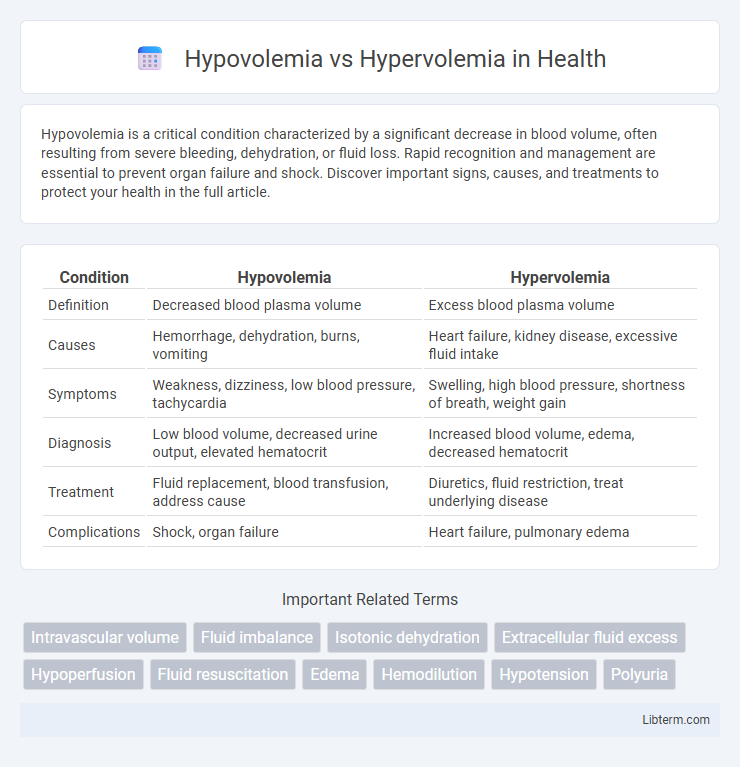Hypovolemia is a critical condition characterized by a significant decrease in blood volume, often resulting from severe bleeding, dehydration, or fluid loss. Rapid recognition and management are essential to prevent organ failure and shock. Discover important signs, causes, and treatments to protect your health in the full article.
Table of Comparison
| Condition | Hypovolemia | Hypervolemia |
|---|---|---|
| Definition | Decreased blood plasma volume | Excess blood plasma volume |
| Causes | Hemorrhage, dehydration, burns, vomiting | Heart failure, kidney disease, excessive fluid intake |
| Symptoms | Weakness, dizziness, low blood pressure, tachycardia | Swelling, high blood pressure, shortness of breath, weight gain |
| Diagnosis | Low blood volume, decreased urine output, elevated hematocrit | Increased blood volume, edema, decreased hematocrit |
| Treatment | Fluid replacement, blood transfusion, address cause | Diuretics, fluid restriction, treat underlying disease |
| Complications | Shock, organ failure | Heart failure, pulmonary edema |
Introduction to Fluid Volume Disorders
Hypovolemia refers to a decreased volume of circulating blood plasma, often caused by dehydration, hemorrhage, or excessive fluid loss, leading to diminished tissue perfusion and potential shock. Hypervolemia involves an excessive increase in blood plasma volume, commonly resulting from conditions like heart failure, kidney disease, or excessive intravenous fluid administration, which can cause edema and hypertension. Understanding these fluid volume disorders is crucial for effective diagnosis and management in clinical settings to maintain optimal fluid balance and prevent complications.
Definition of Hypovolemia
Hypovolemia is a clinical condition characterized by a decreased volume of circulating blood plasma, often leading to inadequate tissue perfusion and oxygen delivery. It commonly results from acute hemorrhage, dehydration, or excessive fluid loss due to vomiting or diarrhea. Accurate identification of hypovolemia is critical for prompt fluid resuscitation and preventing shock or organ failure.
Definition of Hypervolemia
Hypervolemia, also known as fluid overload, is a condition characterized by an excessive volume of fluid in the bloodstream and extracellular space, leading to increased blood volume and pressure. This state often results from conditions such as heart failure, kidney disease, or excessive intravenous fluid administration. In contrast, hypovolemia involves a decreased blood volume, typically caused by bleeding, dehydration, or severe fluid loss.
Causes of Hypovolemia
Hypovolemia is primarily caused by acute blood loss due to trauma or surgery, severe dehydration from excessive vomiting, diarrhea, or inadequate fluid intake, and conditions such as burns or excessive sweating that lead to fluid loss. Other causes include third-spacing of fluids in cases of pancreatitis or peritonitis, and use of diuretics that increase renal fluid excretion. Understanding these causes is critical for prompt diagnosis and management to restore circulatory volume and prevent shock.
Causes of Hypervolemia
Hypervolemia is primarily caused by excessive sodium and water retention often linked to conditions such as congestive heart failure, chronic kidney disease, and liver cirrhosis. Iatrogenic factors including intravenous fluid overload or inappropriate administration of sodium-containing fluids can also contribute significantly to hypervolemia. This fluid imbalance leads to increased blood volume, resulting in edema, hypertension, and potential cardiac stress.
Signs and Symptoms Comparison
Hypovolemia presents with signs such as tachycardia, hypotension, dry mucous membranes, and decreased skin turgor due to decreased circulating blood volume. Hypervolemia manifests through peripheral edema, hypertension, jugular venous distention, and dyspnea caused by fluid overload in the vascular system. Identifying these contrasting symptoms aids in accurate diagnosis and appropriate management of fluid imbalances.
Diagnostic Approaches and Laboratory Findings
Hypovolemia is diagnosed through clinical assessment of signs like hypotension, tachycardia, and poor skin turgor, with laboratory findings showing increased hematocrit, elevated blood urea nitrogen (BUN) to creatinine ratio, and hemoconcentration due to fluid loss. Hypervolemia presents with symptoms such as edema, hypertension, and jugular venous distension, while laboratory results typically reveal diluted serum electrolytes, decreased hematocrit, and low BUN to creatinine ratio indicating fluid overload. Diagnostic imaging, including chest X-rays for pulmonary congestion in hypervolemia, and fluid challenge tests in hypovolemia, further aid in differentiating these volume status abnormalities.
Treatment Strategies for Hypovolemia
Treatment strategies for hypovolemia center on rapid fluid resuscitation using isotonic crystalloids like normal saline or lactated Ringer's solution to restore intravascular volume. Blood transfusions are essential in cases of hemorrhagic hypovolemia to replace lost red blood cells and improve oxygen delivery. Addressing the underlying cause, such as controlling bleeding or treating dehydration, is critical to prevent recurrence and stabilize hemodynamics.
Management of Hypervolemia
Management of hypervolemia involves diuretic therapy, primarily with loop diuretics like furosemide, to promote fluid excretion and reduce extracellular fluid volume. Fluid and sodium intake restrictions are essential to prevent further volume overload, while monitoring electrolyte levels and kidney function guides treatment adjustments. In severe cases, ultrafiltration or dialysis may be necessary to remove excess fluid efficiently.
Prevention and Prognosis
Preventing hypovolemia involves maintaining adequate hydration and monitoring fluid loss due to bleeding, vomiting, or diarrhea, while hypervolemia prevention centers on managing fluid intake and treating underlying conditions such as heart failure or kidney disease. Early detection and prompt treatment improve prognosis in hypovolemia, reducing risks of shock and organ failure. Hypervolemia prognosis depends on controlling volume overload and underlying causes to prevent complications like pulmonary edema and hypertension.
Hypovolemia Infographic

 libterm.com
libterm.com